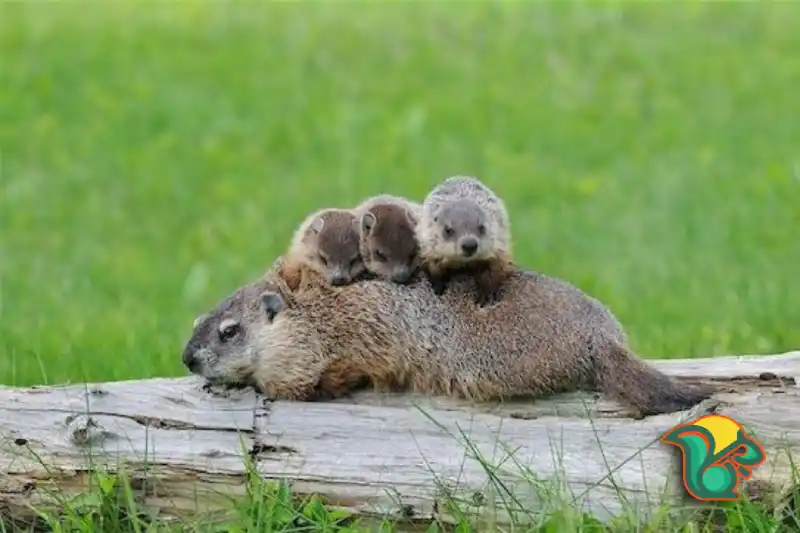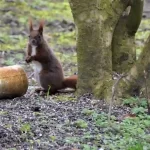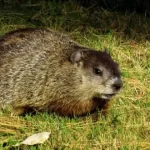How Many Babies do Groundhogs Have?
One can understandably be confused about “how many babies do groundhogs have?” So, we understand you’re curious to know. Hibernating groundhogs give birth to a litter of three to five offspring in the spring.
Three to five young are born to female groundhogs in late February or early March. The newborn puppies weigh just a couple of ounces and have closed eyes and ears. They progress quickly.
Groundhogs, being an extended part of the rodent family, are a look-alike of squirrels. However, when squirrels live in the woods, groundhogs stick to the ground. And this is why they are called groundhogs.
Their life cycle is interesting too! You know that groundhogs live alone, but do they have siblings? How many babies of groundhogs have in a litter? Let’s learn a bit about it!

Mating Season
Before a groundhog gets pregnant, she has to mate with a male groundhog, right? And the mating season is a fact here. So, what time do groundhogs mate and what time of the year do groundhogs have babies? The woodchuck’s mating season is in the early spring or in short, March.
And they have their babies within one month! However, the month depends on the geographic area along with the environmental temperature too. There can be a bit of difference too. They mate immediately after the winter. In the winter, they hibernate.
At times, the hibernation lasts more than six months. And in this period, their weight reduces too. But after they are done with their hibernating season, they wake up and get ready for searching for their partner for mating.
After a baby is born, it requires more or less 2 years to reach sexual maturity, and then, it also contributes to the expansion of their family.
While both sexes of groundhogs are monogamous when it comes to defending their territory, they do not reproduce at the same rate. Home ranges of female groundhogs overlap by around 10% in late spring and early summer.
Most male groundhogs have just a few females in their region, but they nevertheless pay frequent visits to each other.
How Many Babies Do Groundhogs Have?
Now that you know about the mating season of the groundhogs, you might be interested in how many babies do groundhogs have! First, know that groundhogs do not stay pregnant as long as humans do. For us, it’s 10 months or more.
But for the whistle pigs, it’s only one month long. When the female groundhogs give birth, you will see a little of two to six groundhogs. If you talk about the average number of babies a groundhog produces after getting pregnant is four.
They deliver four babies on average. Every year, a female woodchuck will deliver only one litter. The babies that come out are usually hairless. Doesn’t that make you shiver? Yes, these babies are hairless! Along with these, are born blind.
Then why are they known for having good eyesight? Is it true that groundhogs have good eyesight and hearing- learn about it here! On the other hand, the weight of a baby will be nearly 30g.
However, an adult grown-up woodchuck will be of 2 kg to 6.3 kg depending on the gender and growth. No matter how small their holes look, they can ruin your entire property! Here are our thoughts on-are groundhogs dangerous for your yard!

Most baby groundhogs leave their mothers’ dens before they become two months old. For this reason, they serve as a prime example of a species that lacks the ability to effectively raise offspring.
Early spring is when groundhogs breed, and after barely a month of pregnancy, mothers usually have a litter of two to six blind, hairless young.Young groundhogs are born with short, delicate whiskers and are blind until they are around five weeks old. The first signs of soft hair and independent movement appear after about a week. The breeding season for groundhogs begins in the spring.
Groundhog Baby Facts
The groundhog’s mother digs a tunnel for her young, and the young groundhogs spend their first few months of life in the burrow.

She makes a birthing home for herself and her new brood and fills it with soft grasses to make everyone as comfortable as possible throughout the process
The burrow is often referred to as a Somme (which may be pronounced “set”), and it can be as long as 80 feet. However, the birth chamber is typically only around three times the length of the mother. This allows the mother to keep her offspring close to her while preserving warmth.
Although a mother groundhog can have up to ten young, the typical litter size is between three and six young. The young groundhog is referred to as “pups,” “kits,” or even “cubs” at times.
When they reach their adult size, people sometimes refer to them as woodchucks or whistlepigs.
Baby woodchucks are typically pink in color, have no hair at all, and are only about the size of a matchbox car when they are first born. Their eyelids are not even open yet, so their ears are rolled up against their head. They do not even have ears yet.
To a newborn groundhog, the only senses which are active are its sense of touch and its sense of smell.

Baby groundhogs are very sensitive to changes in temperature, and as a result, they cluster close to their mothers in order to keep warm. If they become lost for a short while, they will be able to navigate their way to the nest by using their sense of smell and the warmth that is radiated by their mother and the other members of their litter.
Baby mice create squeaky sounds and scream more loudly when they are hungry or freezing so their mother will notice.
Lifecycle of Groundhog Babies
For the first three weeks of their lives, the pups survive only on their mother’s milk. After that, they may start scavenging for food in the burrow by chewing on anything they find. At 4 weeks, not only do their eyes open, but they also have complete fur.
To introduce her young to new tastes, mom would bring in some grass and flowers.
Snakes are major threats to young groundhogs because they can hear them moving underneath and may easily access the burrow via the entrance
Young groundhogs, bunnies, prairie dogs, and gophers are a few of the favorite foods of the gopher snakes that live in the Southwest’s deserts.
Although young groundhogs have little chance against a full-grown Gopher snake, their mothers will fight valiantly to protect them, and have even been known to kill and devour the snakes that try to harm them.
Growing woodchucks eventually go out of the den for brief periods of time.
They listen for their mother’s piercing, high-pitched whistle and immediately return to the cave when she sounds the alarm.
At around 44 days old, they are able to wean themselves from their mothers’ milk.
Before they’re even 2 months old, baby groundhogs have already built their individual burrows and are living independently, as their mother gradually moves them out of her cave.
Groundhog’s Age
Are all groundhogs the same? Can you tell the difference between an adult and a teenage groundhog? How to tell how old a baby groundhog is? Well, let us answer all of your questions. We have told you way before those groundhogs are born blind.
They come naked and they are hairless too. These newborn groundhogs are kept inside the burrow by their mothers for about four weeks. So, in this stage, they will be hairless, blind, and naked. Also, if you touch a baby groundhog and see that its skin is hotter than regular times, you have to understand that the groundhog’s age is less the four weeks.
When they get into 6 weeks, they start eating veggies. When a groundhog gets a bit aged and they are in their teenage stage, they will not stay in their mother’s burrow. They will move out from the natal den. And eventually, they will dig their burrow.
These are starter burrows and often, they build them a bit away from the fence row. They create their burrows in meadows and farmland areas. The kids or the adolescents spend time playing and gathering food. If a groundhog lives in the wild, it will live up for 6 years or more.
However, in captivity, this age can increase According to surveys; a groundhog can live more or less 14 years if they are kept captive. If you ask what month do groundhogs have babies, you have to learn which month they hibernate! That’s your answer! When the hibernation ends, the breeding season starts.
A Full Grown Adult Groundhog
We all know that groundhogs live alone. It’s not because they don’t want to live with their family, but because safety is their foremost concern. Usually, after two years of their birth, groundhogs get their sexual maturity and get ready for their intercourse with a female or male woodchuck.
But when do they leave their mother and how long do baby groundhogs stay with their mother? After 1 month of the breeding season, a 10 cm long newborn comes. After they are born, they stay inside the burrow of his/her mother for continuously four weeks.
In these four weeks, they are not allowed to go out because they do not know how to safeguard them. And in this period, the mother gives proper care and nurses the child. She feeds the newborn woodchuck with fresh grass.
And when they reach 6 weeks of their age, they are weaned. And after a while, when they are a grown-up of 3 months, they are given their rights to go wherever they want!
At this age, they decide to leave their mother’s burrow and create their own. But they are not yet sexually mature as we said before. Before 2 years of age, they cannot be a complete adult.
Baby Groundhog’s Feelings
As we said, they are born naked which refers to pink in color and they can’t see. But do groundhogs feel when they are born? Yes, woodchucks have the sense of touch when they are born. And as we all know about their smelling power, they have this by birth!
They usually stick to their mothers. But at times, they huddle too! And if they get lost, as they don’t have eyes, they use their nose. They come back to the next by smelling the scent! They can smell their motors and littermates.
However, they are temperature sensitive. They drink milk from their motor for the first 3 weeks and they start learning skills of digging after this period.
While telling the age of the male and female groundhogs, people get a bit confused. In that case, you can have a look at the differences between male vs. female groundhogs and then understand which one you have found.
Frequently Asked Questions
1. How Many Babies Does a Groundhog Have at a Time?
The mating season for groundhogs occurs in the early spring, and after a pregnancy that lasts for barely a month, the female groundhog normally gives birth to a litter of between two and six hairless and blind offspring. Young groundhogs are referred to as kits, puppies, or even chucklings depending on the context.
2. How Long Do Baby Groundhogs Stay With Their Mother?
They are considered weaned and able to live without their mother’s milk at about 44 days old. By the time they are 2 months old, the young groundhogs have already built their own burrows and are living independently, since their mother has begun to relocate them out of her cave.
3. How Often Do Groundhogs Reproduce?
Groundhogs, which belong to the genus Marmota, have very brief pregnancies and devote twice as much to raising their offspring when they are born. In contrast to many of their other rodent cousins, groundhogs only have one litter of young each year. This is in contrast to their other relatives, who tend to be prolific breeders and deliver a baby to many litters of young each year.
4. Do Groundhogs Stay Together as a Family?
Typically, a groundhog family will include one adult male and two adult females, plus any female progeny from the previous mating season and any newborns from this year’s litter. The interactions that take place amongst a group of women are almost always cordial.
Wrap Up
Lovers of groundhogs, these animals are wild, you know. But yes, you can domesticate them too! All you need is to know about them as much as you can. Follow our site and you’ll know every detail of woodchucks. And then, it’ll be easy to tame them or get rid of them when it comes to safeguarding your property!




